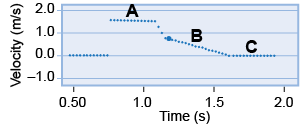 Explain how measuring the height of an icy hill and the speed of a sledder at the top and bottom of the hill can be used to demonstrate energy conservation. Explain how measuring the height of an icy hill and the speed of a sledder at the top and bottom of the hill can be used to demonstrate energy conservation.
 Prove mathematically, using energy arguments, that objects of different mass should fall at the same rate in the absence of friction. Prove mathematically, using energy arguments, that objects of different mass should fall at the same rate in the absence of friction.
- A thrown ball follows a curved path called a trajectory as it first goes up and then comes down again. At what point in the trajectory does the ball have maximum kinetic energy? At what point does it have a maximum potential energy?
- Linda claims that she can defy the law of conservation of energy by riding an elevator and gaining potential energy. Is Linda right? Explain.
- In a closed system where only kinetic and electrical energy are changing, if the kinetic energy is increasing, what is happening to the electrical energy?
- State the law of conservation of energy using delta notation.
- Why is it harder to rub two pieces of sandpaper together than to rub two pieces of notebook paper together?
- When friction removes kinetic energy from an object, what does it typically transform it into?
- When a falling object has reached terminal velocity, what is its efficiency in converting potential energy to kinetic energy?
- Suppose you have a half can of unused, oil-based house paint. Can you dispose of the paint by dumping it down a storm drain at the road side? If not, then how should you properly dispose of the paint?
 When does a pendulum have the highest gravitational potential energy? When does it have the highest kinetic energy? When does a pendulum have the highest gravitational potential energy? When does it have the highest kinetic energy?
 Name two real-life examples of energy transformations, and explain what types of energy are being transformed. Name two real-life examples of energy transformations, and explain what types of energy are being transformed.
 Describe how you used the work–energy theorem to determine the efficiency of the work done by the elastic band in Investigation 10B on page 288. Describe how you used the work–energy theorem to determine the efficiency of the work done by the elastic band in Investigation 10B on page 288.
| |  In a closed system where kinetic, potential, and thermal energy are changing, the kinetic energy decreases by 54 J, and the thermal energy increases by 13 J. What is the change in the potential energy? In a closed system where kinetic, potential, and thermal energy are changing, the kinetic energy decreases by 54 J, and the thermal energy increases by 13 J. What is the change in the potential energy?

 This graph was generated from a real-time graphing technology for the motion of a rolling car. This graph was generated from a real-time graphing technology for the motion of a rolling car.
- Which portion of the graph (A, B, and/or C) corresponds to static friction? Kinetic friction? Rolling friction?
- In which portion of the graph (A, B, and/or C) does velocity change with a sign opposite to the changes in time?
- In which portion of the graph (A, B, and/or C) is the slope negative?
- Write down a symbolic relationship for velocity as a function of time for portion B of the graph.
- Using your equation in the previous question and/or the chart, describe how time varies as a function of velocity for portion B.
 Explain why energy is still conserved when friction causes an object to “lose” energy. Explain why energy is still conserved when friction causes an object to “lose” energy.
 Two friends, Noor and Meera, are pushing boxes. Noor has an efficiency of 50% in pushing her box. Meera pushes her box on a path that is twice as long as Noor’s but has half the friction. Assume Meera pushes with the same amount of force as Noor. Is Meera more or less efficient than Noor? Two friends, Noor and Meera, are pushing boxes. Noor has an efficiency of 50% in pushing her box. Meera pushes her box on a path that is twice as long as Noor’s but has half the friction. Assume Meera pushes with the same amount of force as Noor. Is Meera more or less efficient than Noor?
- A 1.0 kg brick falls off a ledge of height 44 m and lands on the ground 3.0 s later.
- Find the final velocity of the brick using the equations of motion.
- Find the final velocity of the brick using conservation of energy.
 A frictionless roller coaster with a mass of 200 kg starts 15 m above the ground with a speed of 10 m/s. When it is 5 m above the ground what is its speed? A frictionless roller coaster with a mass of 200 kg starts 15 m above the ground with a speed of 10 m/s. When it is 5 m above the ground what is its speed?
|

